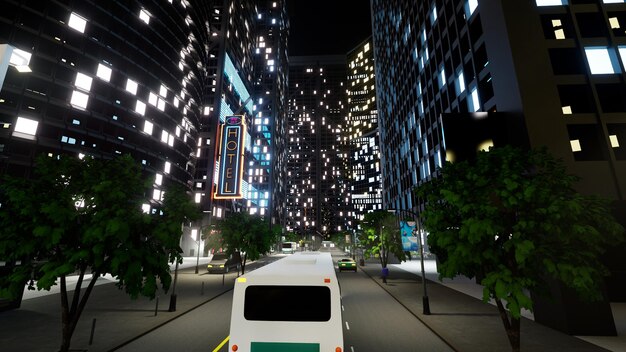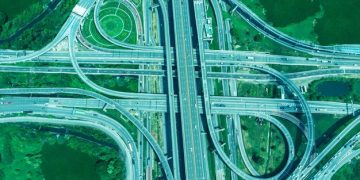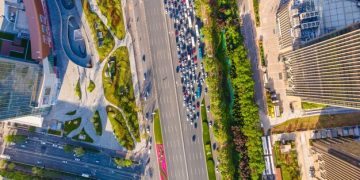Autonomous Vehicles & US Cities: A 2030 Transformation Guide

Autonomous vehicles are poised to fundamentally reshape US urban landscapes by 2030, promising advancements in safety, efficiency, and accessibility, yet simultaneously presenting complex challenges related to infrastructure, employment, and equitable integration within existing societal frameworks.
The dawn of self-driving cars, once confined to the realm of science fiction, is rapidly approaching, bringing with it a profound societal transformation. At the heart of this shift lies the urgent question: The Future of Transportation: How Will Autonomous Vehicles Change US Cities by 2030? This inquiry extends far beyond mere technological novelty, delving into profound implications for planning, infrastructure development, urban economics, and the very fabric of daily life for millions across the United States.
The Dawn of Driverless Mobility: A Technological Glimpse
The advent of autonomous vehicles (AVs) represents a pivotal moment in the history of transportation. By 2030, the US is expected to witness a significant acceleration in the deployment and adoption of these groundbreaking machines, moving beyond mere testing phases into widespread application.
Understanding the technological underpinnings of AVs is crucial to grasping their potential impact. These vehicles rely on a sophisticated array of sensors, including lidar, radar, cameras, and ultrasonic sensors, to perceive their surroundings. This data is then processed in real-time by powerful onboard computers, often leveraging artificial intelligence and machine learning algorithms to interpret the environment and make driving decisions.
Sensor Fusion and AI Algorithms
The synergy between different sensor types, known as sensor fusion, allows AVs to create a comprehensive and redundant understanding of their environment, minimizing blind spots and enhancing reliability. AI algorithms, particularly deep learning models, enable these vehicles to identify objects, predict the movements of other road users, and navigate complex traffic scenarios with increasing proficiency. This continuous learning from vast datasets of real-world driving experiences is what propels AV technology forward.
- Lidar (Light Detection and Ranging): Provides precise 3D mapping of the environment, crucial for accurate distance measurement.
- Radar: Effective in adverse weather conditions, detecting speed and range of objects.
- Cameras: Offer high-resolution visual data for object recognition, lane keeping, and traffic sign interpretation.
- Ultrasonic Sensors: Ideal for short-range detection, aiding in parking and low-speed maneuvers.
The development of these technologies is not static; advancements are made almost daily. As these systems become more refined and robust, the cost of their integration into vehicles is expected to decrease, pushing AVs further into the mainstream. The regulatory landscape, though still evolving, is beginning to provide clearer pathways for deployment, allowing for structured testing and eventual commercialization. This technological maturation fundamentally underpins the transformative changes anticipated across US cities.
Reshaping Urban Infrastructure: Smart Roads and Data Networks
The integration of autonomous vehicles into urban environments is not merely about replacing human drivers; it necessitates a fundamental rethinking of existing infrastructure. By 2030, US cities will likely embark on, or significantly advance, projects aimed at creating “smart” infrastructure that can communicate with AVs, optimizing traffic flow and enhancing safety.
This future infrastructure will move beyond passive tarmac and signage. It will embrace embedded sensors, vehicle-to-infrastructure (V2I) communication systems, and advanced traffic management platforms. These elements will work in concert to create a dynamic transportation ecosystem where vehicles and roads interact seamlessly, sharing critical information in real-time. This could involve traffic light optimization based on vehicle density, early warning systems for road hazards, or even dynamic lane reconfigurations.
The Role of 5G and Edge Computing
The backbone of this smart infrastructure will undoubtedly be robust and low-latency communication networks, predominantly 5G. This technology is vital for the rapid exchange of data between AVs, other vehicles (V2V), and the city’s infrastructure. Furthermore, edge computing – processing data closer to the source – will reduce latency, crucial for split-second decision-making in autonomous driving.
- Connected Traffic Lights: Lights can adjust timing based on real-time traffic demand from AVs.
- Smart Parking Systems: AVs can autonomously locate and navigate to available parking spaces, reducing congestion.
- Dynamic Lane Management: Lanes can be reconfigured for peak flows, such as converting a general lane to an AV-only lane during rush hour.
- Enhanced Mapping and Localization: High-definition maps will be continually updated via vehicle data, providing AVs with precise location information.

Investments in these areas will be substantial, requiring significant governmental and private sector collaboration. Retrofitting older urban areas with this new technology presents a unique challenge, often more complex than building from scratch. However, the long-term benefits in terms of reduced congestion, improved air quality, and enhanced safety are expected to outweigh the initial costs, transforming the very layout and functionality of city streets. The interplay between physical and digital infrastructure will define the urban mobility of 2030.
Urban Planning and Land Use: Beyond the Parking Lot
One of the most consequential yet often overlooked impacts of autonomous vehicles will be on urban planning and land use. As AVs become prevalent by 2030, the demand for traditional parking spaces, particularly in dense urban cores, is projected to diminish significantly. This shift will free up vast swathes of valuable urban land, presenting unprecedented opportunities for redevelopment.
Consider the typical city structure today, where expansive parking lots and multi-story garages consume prime real estate. With fleets of shared autonomous vehicles, cars will spend less time parked and more time in active use, picking up and dropping off passengers, or even self-parking in designated, out-of-the-way areas. This means spaces currently dedicated to parking could be reimagined as parks, affordable housing, commercial establishments, or pedestrian-friendly zones, enhancing urban liveability and sustainability.
Redefining Public Space and Green Initiatives
The reduction in privately owned vehicles and the potential for a more efficient and shared transportation system could also lead to a decrease in the overall number of vehicles on city streets. This could allow for narrower roads, wider sidewalks, and dedicated lanes for micro-mobility solutions, such as e-scooters and bicycles. Imagine urban environments optimized for people, not just cars, with expanded green spaces and communal areas.
- Repurposed Parking Lots: Convert existing parking infrastructure into public plazas, green spaces, or mixed-use developments.
- Reduced Road Widths: As traffic efficiency improves, road widths might be reduced, allowing for wider pedestrian walkways and bike lanes.
- Transit-Oriented Development (TOD) Emphasis: AVs could serve as a first-mile/last-mile solution, enhancing the reach and appeal of public transit, fostering denser, more walkable communities around transit hubs.
- Reduced Sprawl: More efficient transportation could decrease the pressure for urban sprawl, encouraging denser, more sustainable development patterns within existing city limits.
Furthermore, the ability of AVs to operate continuously could facilitate the creation of goods delivery networks that are far more efficient, potentially reducing the need for large urban distribution centers and minimizing freight traffic during peak hours. This evolution in land use will require careful planning and policy formulation by city officials, ensuring that these newfound opportunities are leveraged to create more equitable, sustainable, and vibrant urban landscapes for all residents.
Economic Shifts and Employment Realities: A Dual Impact
The widespread adoption of autonomous vehicles by 2030 will undoubtedly trigger significant economic shifts, presenting both promising opportunities and considerable challenges, particularly concerning employment. While the technology is poised to create new industries and job roles, it will also likely displace a substantial number of jobs in traditional transportation sectors.
On the one hand, the AV industry itself will necessitate a workforce skilled in software development, AI engineering, cybersecurity, sensor manufacturing, and specialized maintenance. There will be new roles in fleet management for autonomous vehicles, data analysis related to traffic patterns, and the design of the aforementioned smart infrastructure. This represents a burgeoning sector with high-paying, technologically advanced jobs that could fuel economic growth.
Impact on Traditional Driving Professions
Conversely, the most immediate and pronounced economic impact will be on jobs centered around human driving. Taxi drivers, ride-share operators, long-haul truck drivers, delivery personnel, and bus drivers are all roles that could see significant automation. While the transition may be gradual, by 2030, many of these professions could experience considerable disruption, necessitating large-scale workforce retraining and social safety nets.
- Job Creation: Growth in software engineering, AI specialists, sensor manufacturing, cybersecurity.
- Job Displacement: Significant impact on professional drivers (taxi, truck, bus, delivery).
- New Service Industries: Emergence of new services around AV fleet management, maintenance, and cleaning.
- Insurance Industry Transformation: Shift from individual driver liability to manufacturer and AI liability, leading to new insurance models.
Beyond direct employment, AVs could influence other sectors. The logistics and delivery industries stand to benefit from increased efficiency and reduced labor costs. Real estate markets might see changes as commuting patterns evolve and parking becomes less of a premium. Policymakers will face the critical task of managing this transition, investing in education and retraining programs, and potentially exploring new economic models to support displaced workers. The economic narrative of AVs by 2030 will be one of profound reorientation, demanding adaptive strategies from individuals, businesses, and governments.
Safety, Accessibility, and Equity: Heralding a New Era
The promise of autonomous vehicles extends significantly into the realms of safety, accessibility, and urban equity. While the path to full realization is complex, by 2030, AVs are anticipated to make tangible strides in reducing road fatalities and improving mobility for underserved populations in US cities.
Safety is perhaps the most compelling argument for AV adoption. Human error accounts for over 90% of all road accidents. Autonomous vehicles, programmed to adhere strictly to traffic laws, avoid distractions, and react with superhuman speed, have the potential to drastically reduce collisions, injuries, and deaths. This inherent safety feature could lead to lower insurance premiums and create safer streets for pedestrians and cyclists.
Enhanced Accessibility for All
Beyond safety, AVs offer unprecedented opportunities for enhanced accessibility. For the elderly, individuals with disabilities, and those unable to drive for various reasons, autonomous vehicles can provide a newfound sense of independence and mobility. This could reduce social isolation, improve access to healthcare, employment, and recreational activities, and fundamentally change their quality of life. Ride-sharing AV fleets could make transportation more affordable and readily available than traditional car ownership or current ride-hailing services, especially in areas underserved by public transit.
- Reduced Accidents: Significant decrease in human error-related collisions.
- Increased Mobility: Greater independence for the elderly, disabled, and non-drivers.
- Equitable Access: Potential for more affordable and widespread transportation services in underserved communities.
- Reduced Drunk Driving: Elimination of impaired driving-related incidents.
- Emergency Response Improvements: Potential for AVs to serve as rapid response vehicles, or clear paths for emergency services.
However, achieving true equity requires careful consideration. Ensuring that AV services are affordable and readily available in all communities, not just affluent ones, will be critical. Addressing potential digital divides and designing user interfaces that are intuitive for all demographics will also be paramount. The transition to an AV-powered transportation system must be managed with a strong focus on inclusive growth, ensuring that the benefits are shared broadly and do not exacerbate existing societal inequalities in US urban centers.
Regulatory Landscape and Public Perception: Navigating the Future
The transition to a widespread autonomous vehicle ecosystem by 2030 is heavily contingent on two critical factors: the development of a coherent and comprehensive regulatory framework, and the evolution of public perception and trust. Both elements are deeply intertwined and will dictate the pace and nature of AV integration into US cities.
Currently, the regulatory landscape across the United States is fragmented, with different states and even municipalities adopting varying approaches to AV testing and deployment. This patchwork of regulations creates uncertainty for manufacturers and operators. By 2030, a more unified national framework, or at least a set of widely accepted guidelines, will be essential to ensure consistent safety standards, liability rules, and operational protocols. This will involve complex negotiations between federal agencies, state governments, and industry stakeholders.
Building Trust and Addressing Ethical Dilemmas
Public perception remains a significant hurdle. Despite the technological advancements, many individuals harbor concerns about the safety and reliability of self-driving cars. High-profile accidents, even if rare, disproportionately influence public opinion. Building trust will require transparent reporting of safety data, public education campaigns, and clear demonstrations of AV capabilities in real-world scenarios. Addressing ethical dilemmas, such as algorithmic decision-making in unavoidable accident situations, will also be crucial for gaining broad public acceptance.
- Standardized Regulations: Need for consistent national and state laws for AV testing and deployment.
- Liability Frameworks: Clear rules determining responsibility in case of accidents involving AVs.
- Data Privacy Concerns: Addressing how AVs collect, store, and use personal and trip data.
- Public Education Campaigns: Informing the public about AV safety and benefits to build trust.
- Ethical Guidelines: Development of principles for AV programming, particularly concerning “trolley problem” scenarios.
Moreover, local government buy-in is vital. City leaders will need to understand the benefits and challenges, and actively participate in shaping local policies that support AV integration while addressing community concerns. The interplay of effective regulation, robust safety records, and proactive public engagement will be the bedrock upon which the widespread adoption of autonomous vehicles in US cities by 2030 is built, transforming the theoretical into a tangible reality.
Environmental Impact and Sustainable City Futures
The environmental repercussions of autonomous vehicles are a multifaceted topic, holding the potential to significantly contribute to or detract from sustainable city futures depending on how their deployment is managed. By 2030, the trajectory of this impact will become clearer, with strong arguments for both positive and negative outcomes regarding urban emissions, energy consumption, and environmental justice.
On the positive side, if AV fleets largely consist of electric vehicles (EVs), the reduction in tailpipe emissions could be profound, particularly in dense urban areas where pollution is concentrated. AVs, being more efficient drivers than humans, could also optimize routes, reduce idling, and minimize rapid braking and acceleration, all of which contribute to lower energy consumption and reduced emissions across the fleet. This efficiency, combined with increased ride-sharing, could lead to a net reduction in the total number of vehicles on the road.
The Rebound Effect and Energy Demands
However, a potential “rebound effect” exists. If autonomous transportation becomes exceptionally convenient and affordable, it could encourage more travel, leading to an overall increase in vehicle miles traveled (VMT). This surge in VMT, even with efficient electric AVs, would place greater demands on electricity grids, necessitating a significant expansion of renewable energy sources to maintain environmental benefits. Furthermore, the sheer volume of data generated by AVs and the computing power required for their operation also have an energy footprint that must be considered.
- Reduced Emissions: Significant decrease in tailpipe emissions if AVs are primarily electric.
- Optimized Driving: More efficient acceleration, braking, and routing for lower energy consumption.
- Increased Ride-sharing: Potential for fewer privately owned vehicles and reduced urban congestion.
- Potential for Increased VMT: Greater convenience might lead to more frequent and longer trips.
- Battery Recycling Challenges: As AVs contribute to EV growth, efficient battery recycling becomes critical.
Cities aiming for true sustainability will need to couple AV integration with robust policies promoting electric vehicle adoption, investing in green energy infrastructure, and encouraging multi-modal transportation options. The goal is not just to replace cars with AVs, but to strategically leverage AV technology to create more environmentally friendly and energy-efficient urban mobility systems that align with broader climate action goals. The choices made by 2030 will profoundly shape the environmental legacy of autonomous vehicles in powering sustainable cities.
| Key Aspect | Brief Description |
|---|---|
| 🚀 Tech Evolution | Advanced sensors & AI will enable widespread AV deployment, enhancing perception & decision-making. |
| 🏙️ Urban Redesign | Reduced parking needs will free up land for parks & housing, reshaping cityscapes. |
| 💼 Economic Impact | New tech jobs will emerge, but traditional driving roles face significant disruption. |
| 🚦 Safety & Access | AVs promise fewer accidents and enhanced mobility for underserved populations, pending equitable access. |
Frequently Asked Questions About Autonomous Vehicles by 2030
By 2030, autonomous vehicles are expected to be highly reliable for many common driving scenarios, especially in defined operational design domains (ODDs). However, “entirely reliable” in all possible extreme conditions may still be aspirational. Ongoing testing and regulatory advancements will continue to enhance their capabilities, but human oversight or intervention might still be required in some edge cases.
Cities and governments are expected to implement retraining programs, educational initiatives, and potentially universal basic income or other social safety nets to support workers displaced by AVs. The focus will be on transitioning skilled laborers from traditional driving roles into new opportunities within the AV industry, infrastructure development, or other burgeoning sectors.
No, the adoption rate of autonomous vehicles will likely vary significantly across US cities. Factors influencing pace include existing infrastructure, local government willingness to adapt regulations, public acceptance, economic conditions, and population density. Densely populated tech-forward cities are more likely to lead the adoption curve faster than rural or less prepared urban areas.
Autonomous vehicles are likely to complement public transportation by 2030, rather than fully replace it. They can serve as efficient “first-mile/last-mile” solutions, connecting residents to transit hubs and expanding the reach of public transit networks. It could also lead to more flexible, on-demand public transit models with smaller, self-driving shuttles.
Data privacy and cybersecurity are critical concerns for AVs. By 2030, robust regulations and industry standards will be vital to protect sensitive personal and travel data collected by AVs. Manufacturers will need to implement advanced encryption and cybersecurity measures, while governments will establish frameworks governing data ownership, usage, and sharing to ensure consumer trust.
Conclusion
By 2030, autonomous vehicles are set to be more than just a novelty; they are poised to be a foundational element transforming US cities. From reshaping urban landscapes and infrastructure to redefining economic sectors and enhancing societal accessibility, the implications are vast and complex. While the journey presents engineering challenges, policy hurdles, and shifts in public perception, the potential benefits in safety, efficiency, and quality of life for urban dwellers are undeniable. The future of urban transportation will demand thoughtful collaboration and adaptive strategies to fully harness this transformative technology, ensuring a truly smarter, safer, and more connected urban experience.





